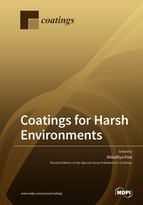Coatings for Harsh Environments
A special issue of Coatings (ISSN 2079-6412).
Deadline for manuscript submissions: closed (15 January 2020) | Viewed by 74169
Special Issue Editor
2. Materials Innovation Centre, School of Engineering, University of Leicester, Leicester LE1 7RH, UK
Interests: corrosion; coatings; electrochemistry; thermal spraying
Special Issues, Collections and Topics in MDPI journals
Special Issue Information
Dear Colleagues,
The operation of numerous safety-critical components in industries around the world rely on protective coatings. These coatings often allow process equipment to be purposeful in environments well beyond the operational limit of the uncoated components. Durability, ease of application, repairability, reliability and long-term performance of such coatings are key to their application. Therefore, this Special Issue of Coatings, “Coatings for Harsh Environments” is devoted to research and review articles on the metallic, non-metallic and composite coatings used in aggressive environments.
In particular, the topics of interest include, but are not limited to:
- Coatings for high temperature and molten salt applications;
- Coatings for mitigating corrosion in CO2 and H2S environments;
- Thermal spray and cold spray coatings for aggressive environments;
- Corrosion, wear and cavitation resistant coatings;
- Coatings for mitigating marine corrosion;
- Coatings for deep sea applications;
- Coatings for nuclear applications;
- Coating for chemical and petrochemical plants;
- Coatings for aeroengine turbines;
- Coatings for applications in space;
- Coatings for oil sands and other oil and gas exploration and production environments.
Dr. Shiladitya Paul
Guest Editor
Manuscript Submission Information
Manuscripts should be submitted online at www.mdpi.com by registering and logging in to this website. Once you are registered, click here to go to the submission form. Manuscripts can be submitted until the deadline. All submissions that pass pre-check are peer-reviewed. Accepted papers will be published continuously in the journal (as soon as accepted) and will be listed together on the special issue website. Research articles, review articles as well as short communications are invited. For planned papers, a title and short abstract (about 100 words) can be sent to the Editorial Office for announcement on this website.
Submitted manuscripts should not have been published previously, nor be under consideration for publication elsewhere (except conference proceedings papers). All manuscripts are thoroughly refereed through a single-blind peer-review process. A guide for authors and other relevant information for submission of manuscripts is available on the Instructions for Authors page. Coatings is an international peer-reviewed open access monthly journal published by MDPI.
Please visit the Instructions for Authors page before submitting a manuscript. The Article Processing Charge (APC) for publication in this open access journal is 2600 CHF (Swiss Francs). Submitted papers should be well formatted and use good English. Authors may use MDPI's English editing service prior to publication or during author revisions.
Related Special Issue
- Coatings Challenges in Harsh Environments in Coatings (4 articles)






